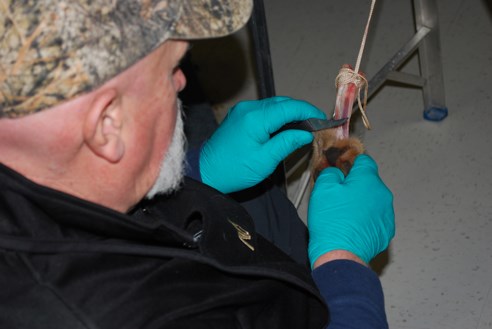The 2014 Thompson fur tables have come and gone, and the numbers show a tougher year for trappers. A total of 5,246 furs came through the door, generating total sales of $239,421. Last year’s fur tables saw $618,852 change hands.
Fred Fitzner from Wabowden says trapping has been hard this season. “It’s been slow. The people I’ve talked to in different communities say it’s not as good as its been in the past. There’s one good reason it’s likely that it’s the snow last year. It was very cold, so a lot of animals probably died out.” Fitzner has been a member of the Manitoba Trappers Association (MTA) for the past 35 years. This year he just hopes the trappers can make some money. “Everyone hopes for the best, to get the best price they can get. Like I’ve said though, the economy is down, everything is down, and there are not too many people buying fur. I just hope the best for all the trappers here.”
This year 211 trappers made the trek to St. Joseph’s Ukrainian Catholic Church hall on Dec. 19-20. Marten, like last year, was the most trapped animal with 3,712 pelts coming to the tables. Mink came in second with 297, beaver was third with 285, and fourth went to muskrat with 232 brought to the tables to be sold.
Money-wise, marten made up the bulk of the sales. Each fur sold for an average of $50, bringing in $185,600. Lynx was second, selling at an average of $120 for a total of $17,520. Wolf pelts sold for an average of $160 each and there were 34 sold for a total of $5,440.
Lane Boles, director-at-large for MTA, says the fur tables have changed over the years. “The last 18 years have seen little changes, but 25 years ago it used to be a huge thing. It used to be held in the Elks Hall, the fur part was upstairs. Downstairs it was crafters, all the ladies through the north brought in slippers, and gauntlets, beautiful fur and leather goods.”
Boles says it’s getting tougher for a lot of crafters because they make the items, then sit on them for awhile, and then don’t get enough money to buy more fur and materials. “The art of crafting and beadwork is slowly dying out.”
During this year’s fur tables, two or three crafters set up to sell their items.
Boles wants the trappers and buyers to be happy with this year’s fur tables. “There isn’t really a goal. We aren’t looking at numbers, the numbers are important to the business community. The numbers for us are, did people enjoy themselves, did they get a fair price, and are they happy the fur tables are continuing? That’s the numbers or the goal we look for.”
Boles does have one personal goal for the fur tables. “My personal goal is to keep it in Thompson. Things are progressing with the businesses. The city may be able to get us some help financially. We did get an email through the Chamber of Commerce, via MKO [Manitoba Keewatinowi Okimakanak], that the Nuclear Waste Management Organization has given us a donation to help us pay for expenses. It’s a one-time shot of $2,500.”
The City of Thompson, the Thompson Chamber of Commerce, the Thompson Regional Airport Authority and Thompson Unlimited split the cost of coffee and tea for the two-day event.




